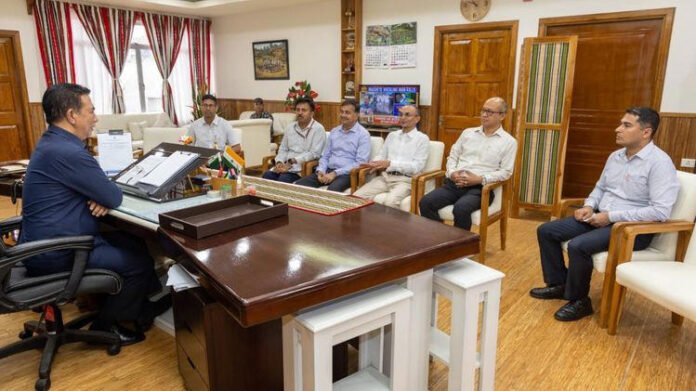Mizoram Chief Minister Lalduhoma recently conducted a comprehensive review of the much-anticipated Bairabi–Sairang railway line project. The review meeting, held with senior officials of the Northeast Frontier Railway (NFR) and state departments, confirmed that the railway line is nearing completion and will be inaugurated after June 17, marking a historic milestone for Mizoram’s development journey.
The Bairabi–Sairang railway project, which spans approximately 51 kilometers, is poised to transform transportation in the state by linking Mizoram’s capital Aizawl to the national railway network via Bairabi, the state’s existing railhead. Once operational, the line is expected to significantly reduce travel time, boost economic activity, and enhance logistical efficiency in the Northeast.
Read More: Mizoram CSS Employees Launch 3-Day Strike Demanding Job Regularisation
CM Lalduhoma Emphasizes Timely Completion and Quality
During the review, Chief Minister Lalduhoma praised the ongoing work but also stressed the importance of adhering to quality standards and meeting the final deadlines. He directed concerned agencies to ensure that all safety inspections, technical checks, and civil works are completed without delay.
“This project is not just about trains—it’s about connecting Mizoram with the rest of India more closely. We are committed to seeing this through and making sure our people benefit from modern, reliable rail services,” the Chief Minister stated.
He also thanked the Indian Railways and Northeast Frontier Railway for their cooperation and consistent efforts despite challenges posed by the difficult terrain and weather conditions.
Inauguration Expected After June 17
Officials from the Northeast Frontier Railway confirmed that the final stages of the project—mainly track alignment testing, signal integration, and station readiness—are underway. A tentative inauguration date has been set for after June 17, pending final clearance from safety authorities and the central government.
Sources suggest that the inauguration will likely be attended by top dignitaries from both the central and state governments, highlighting its importance in the region’s infrastructural narrative.
Once operational, the line will make Aizawl, Mizoram’s capital, directly accessible by train for the first time in history—an achievement that underscores India’s commitment to inclusive development in the Northeast.
Economic and Social Impact of the Bairabi–Sairang Railway Line
The Bairabi–Sairang railway line is expected to have far-reaching economic and social benefits. It will facilitate faster movement of goods, especially essential commodities, agricultural produce, and industrial materials. Businesses and traders in Mizoram will gain direct access to mainland markets, thereby lowering costs and increasing competitiveness.
For the general public, the railway will offer a safer, more affordable, and convenient travel option compared to road transport, which is often affected by landslides, heavy rain, and poor road conditions.
Additionally, the railway line is expected to boost tourism by making Aizawl and its surrounding scenic landscapes more accessible to travelers from across the country.
Part of India’s Act East Policy and Northeast Development
The project is part of the broader Act East Policy, aimed at enhancing connectivity in the Northeast and integrating it more effectively with Southeast Asian trade corridors. The Bairabi–Sairang line, being a crucial link in this strategy, is seen as a foundation for future projects like rail extensions towards Myanmar and other border trade routes.
The central government, under its Northeast Special Infrastructure Development Scheme (NESIDS), has been prioritizing connectivity projects in remote and underserved regions, and Mizoram is at the forefront of this push.
A New Chapter for Mizoram’s Connectivity
As Mizoram gears up for the historic launch of the Bairabi–Sairang railway line post-June 17, the state stands on the brink of a transportation revolution. Chief Minister Lalduhoma’s hands-on review reflects the government’s commitment to efficient governance and regional development.
Once operational, this railway project will not only improve accessibility but also create a ripple effect across sectors—fueling trade, tourism, and socio-economic growth in Mizoram and beyond.




